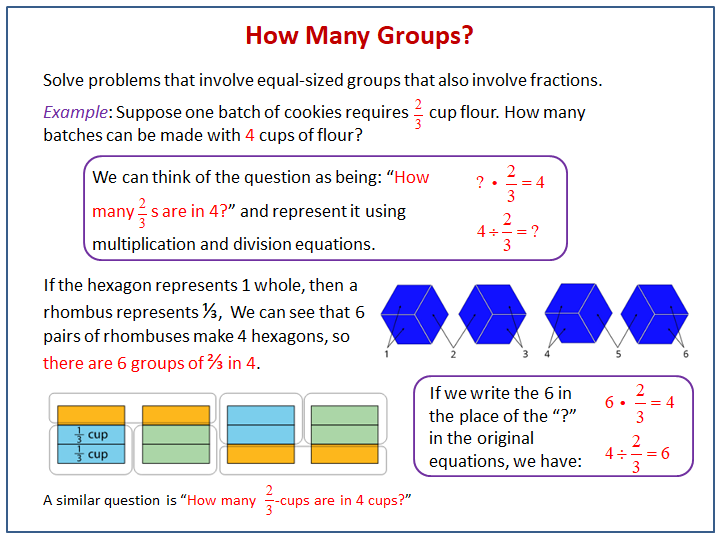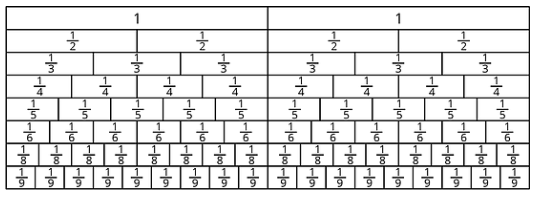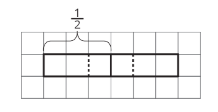Illustrative Mathematics Unit 6.4, Lesson 5: How Many Groups? (Part 2)
Learning Targets:
- I can find how many groups there are when the number of groups and the amount in each group are not whole numbers.
Related Pages
Illustrative Math
Grade 6
Lesson 5: How Many Groups? (Part 2)
Let’s use blocks and diagrams to understand more about division with fractions.
Illustrative Math Unit 6.4, Lesson 5 (printable worksheets)
Lesson 5 Summary
The following diagram shows more examples of how to solve problems that involve equal-sized groups that also involve fractions.

Lesson 5.1 Reasoning with Fraction Strips
Write a fraction or whole number as an answer for each question. If you get stuck, use the fraction strips. Be prepared to share your strategy.
- How many ½s are in 2?
- How many ⅕s are in 3?
- How many ⅛s are in 1¼?
- 1 ÷ 2/6 = ?
- 2 ÷ 2/9 = ?
- 4 ÷ 2/10 = ?
Lesson 5.2 More Reasoning with Pattern Blocks
Use the pattern blocks in the applet to answer the questions. (If you need help aligning the pieces, you can turn on the grid.)
Show Applet
- If the trapezoid represents 1 whole, what do each of the following shapes represent? Be prepared to show or explain your reasoning.
a. 1 triangle
b. 1 rhombus
c. 1 hexagon - Use pattern blocks to represent each multiplication equation. Use the trapezoid to represent 1 whole.
a. 3 · ⅓ = 1
b. 3 · ⅔ = 2 - Diego and Jada were asked “How many rhombuses are in a trapezoid?”
- Diego says, “1⅓. If I put 1 rhombus on a trapezoid, the leftover shape is a triangle, which is ⅓ of the trapezoid.”
- Jada says, “I think it’s 1⅓. Since we want to find out ‘how many rhombuses,’ we should compare the leftover triangle to a rhombus. A triangle is ⅓ of a rhombus.”
- Select all equations that can be used to answer the question: “How many rhombuses are in a trapezoid?”
a. ⅔ ÷ ? = 1
b. ? ÷ ⅔ = 1
c. 1 ÷ ⅔ = ?
d. 1 · ⅔ = ?
a. ? ÷ ⅔ = 1
Lesson 5.3 Drawing Diagrams to Show Equal-sized Groups
For each situation, draw a diagram for the relationship of the quantities to help you answer the question. Then write a multiplication equation or a division equation for the relationship. Be prepared to share your reasoning.
- The distance around a park is 3/2 miles. Noah rode his bicycle around the park for a total of 3 miles. How many times around the park did he ride?
- You need ¾ yard of ribbon for one gift box. You have 3 yards of ribbon. How many gift boxes do you have ribbon for?
- The water hose fills a bucket at ⅓ gallon per minute. How many minutes does it take to fill a 2-gallon bucket?
Are you ready for more?
How many heaping teaspoons are in a heaping tablespoon? How would the answer depend on the shape of the spoons?
Lesson 5 Practice Problems
- Use the tape diagram to represent and find the value of ½ ÷ ⅓.
Mark up and label the diagram as needed. - What is the value of ½ ÷ ⅓? Use pattern blocks to represent and find this value. The yellow hexagon represents 1 whole. Explain or show your reasoning.
- Use a standard inch ruler to answer each question. Then, write a multiplication equation and a division equation that answer the question.
a. How many ½s are in 7?
b. How many ⅜s are in 6?
c. How many 5/10s are in 1⅞? - Use the tape diagram to represent and answer the question: How many ⅖s are in 1½?
Mark up and label the diagram as needed. - Write a multiplication equation and a division equation to represent each question, statement, or diagram.
a. There are 12 fourths in 3.
b. c. How many ⅔s are in 6?
d. - At a farmer’s market, two vendors sell fresh milk. One vendor sells 2 liters for $3.80, and another vendor sells 1.5 liters for $2.70. Which is the better deal? Explain your reasoning.
- A recipe uses 5 cups of flour for every 2 cups of sugar.
a. How much sugar is used for 1 cup of flour?
b. How much flour is used for 1 cup of sugar?
c. How much flour is used with 7 cups of sugar?
d. How much sugar is used with 6 cups of flour?
The Open Up Resources math curriculum is free to download from the Open Up Resources website and is also available from Illustrative Mathematics.
Try the free Mathway calculator and
problem solver below to practice various math topics. Try the given examples, or type in your own
problem and check your answer with the step-by-step explanations.

We welcome your feedback, comments and questions about this site or page. Please submit your feedback or enquiries via our Feedback page.






